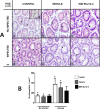Gestational exposure to the cannabinoid WIN 55,212-2 and its effect on the innate intestinal immune response
- PMID: 31889093
- PMCID: PMC6937228
- DOI: 10.1038/s41598-019-56653-y
Gestational exposure to the cannabinoid WIN 55,212-2 and its effect on the innate intestinal immune response
Abstract
The consequences of marijuana consumption during pregnancy and its effects on the function of the immune system have been little studied. Marijuana is one of the most consumed recreational drugs among pregnant women, and it is known that gestational exposure to marijuana can have serious effects on the offspring after birth. In this study, we challenged the immune system of Wistar rats by infecting them with the parasitic nematode Trichinella spiralis. A treatment group of these animals was prenatally exposed to the cannabinoid WIN 55,212-2; a control group was not exposed. At 5 days of infection, the treated animals were less effective in eliminating intestinal parasites; moreover, this effect was correlated with a deficiency in mucus production, lower recruitment of eosinophils in the duodenum, and a reduced percentage of Tγδ and NK cells. In conclusion, the gestational administration of the synthetic cannabinoid WIN 55,212-2 induces lasting changes to the function of the immune system against infection with T. spiralis in male Wistar rats, making them more susceptible to infection.
Conflict of interest statement
The authors declare no competing interests.
Figures








References
-
- Center for Behavioral Health Statistics and Quality. Results from the 2017 National Survey on Drug Use and Health: Detailed tables. Substance Abuse and Mental Health Services Administration, https://www.samhsa.gov/data/sites/default/files/cbhsq-reports/NSDUHDetai... (2018).
-
- United Nations Office on Drugs and Crime. World drug report 2015, https://www.unodc.org/documents/wdr2015/World_Drug_Report_2015.pdf (2016).
-
- Harbison RD, Mantilla-Plata B. Prenatal toxicity, maternal distribution and placental transfer of tetrahydrocannabinol. J. Pharmacol. Exp. Ther. 1972;180:446–453. - PubMed
Publication types
MeSH terms
Substances
LinkOut - more resources
Full Text Sources
Miscellaneous

